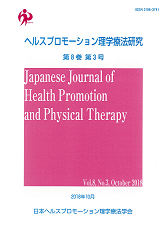Volume 8, Issue 4
Displaying 1-7 of 7 articles from this issue
- |<
- <
- 1
- >
- >|
ORIGINAL ARTICLES
-
Article type: original article
2019Volume 8Issue 4 Pages 153-162
Published: January 31, 2019
Released on J-STAGE: March 29, 2019
Download PDF (357K) -
Article type: original article
2019Volume 8Issue 4 Pages 163-168
Published: January 31, 2019
Released on J-STAGE: March 29, 2019
Download PDF (342K) -
Article type: original article
2019Volume 8Issue 4 Pages 169-173
Published: January 31, 2019
Released on J-STAGE: March 29, 2019
Download PDF (282K) -
Article type: original article
2019Volume 8Issue 4 Pages 175-179
Published: January 31, 2019
Released on J-STAGE: March 29, 2019
Download PDF (327K) -
Article type: original article
2019Volume 8Issue 4 Pages 181-185
Published: January 31, 2019
Released on J-STAGE: March 29, 2019
Download PDF (311K)
SHORT REPORT
-
Article type: short report
2019Volume 8Issue 4 Pages 187-191
Published: January 31, 2019
Released on J-STAGE: March 29, 2019
Download PDF (541K)
FIELD REPORT
-
Article type: field report
2019Volume 8Issue 4 Pages 193-200
Published: January 31, 2019
Released on J-STAGE: March 29, 2019
Download PDF (347K)
- |<
- <
- 1
- >
- >|
